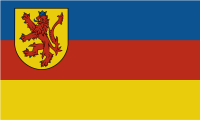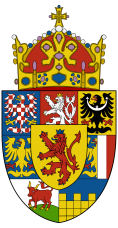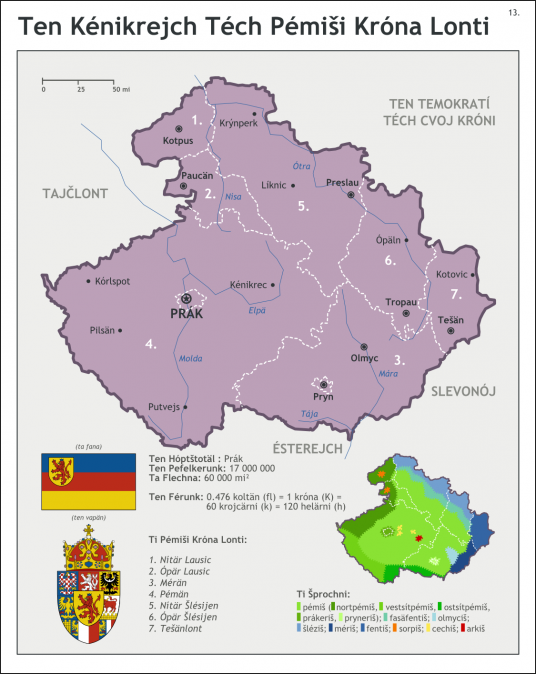Bohemia

| |
| National motto: Veritas vincit! | |
| Languages | |
| Official | Bohemian |
| Other | Venedic, Silesian, Slvanjek (Slevan), Moravian, Lusatian, Czech, Arkian, Yiddish, German |
| Major religions | Common Bohemian Church, Roman Catholicism, Judaism, The Way to the Fourth Worshiping |
| Capital | Prák (Prague, Praha) |
| Important Cities | Kotpus (Cottbus), Paucän (Bautzen), Preslau (Breslau), Pryn (Brünn), Tropau (Troppau), Tešän (Teschen), Olmyc (Olmütz) |
| Subdivisions | 7 federal territories (Bohemia, Moravia, Upper and Lower Silesia, Upper and Lower Lusatia, Tesenlont); 52 counties (Ten päcirk), the autonomous municipalities (Prague, Brenno, Olmutz) |
| Government type | Constitutional parliamentary federative monarchy with a hereditary king/queen |
| Head of state | Her Royal Majesty Queen Katerína I. foncu Hapšpurk (Catherine I. of Hapsburg) |
| Head of government | Chancellor: Franc Fišär |
| Area | 60 000 sq. miles |
| Population | 17,084,627 (2003) |
| Establishment | 1212 |
| Currency | 1 króna (K) = 20 krojcärni (k) = 240 helärni (h) |
| Neighbouring countries | (clockwise) RTC, Slevania, Austria, Holy Roman Empire |
| International organisations | League of Nations European Federation |
Description
A quiet and idyllic country in the heart of Europe. Well, the idyll is rather bucolic and consists of beer, pork and sauerkraut, but it is indisputable that Bohemians are clever, laborious, wealthy and thus a self-satisfied people. There is a saying: "Everything touched by a Bohemian labourer turns gold." It is true on both sides; life standard and salaries are high and Bohemians are known to be slow, but precise and quite skilled. Fine mechanisms, light and heavy machinery, crystal glass, pottery. Their German neighbours say quite often that they are also slow-thinking. Well, it looks so, but do not be mistaken, slow does not mean stupid. There were and are quite a few well-known scientists living and working in BK: S. Hejrovski (polarography), S. Frojt (analytical psychology), O. Vichterle (chemistry, eye-lenses), H.E. Purkajna (cell biology), H.K. Mentl (genetics), K. Kétl (mathematics), E. Mach (physics).
The kingdom is a relatively calm pot of nations. The majority are Bohemians; jovial, smiley, friendly. Well, some people say their smile is sometimes more of mockery, some people say their breezy is sometimes more of fence-sittery. Definitely they are proud to be Bohemians. It goes so far as to say that they "bohemicise" anything they would like to proudly present, which is almost everything related to pre-Hapsburgian Czechs: their kings, traditions and even names.
The second largest nationality in BK are the Slavo-Romans, represented by Veneds, Silesians, Slevans and Moravians. Except for the irredentic Slevans, these are content citizens. The Silesians and Moravians, especially, do enjoy a very high degree of autonomy and cultural independence. Both are known for living folklore traditions often used to show the foreign politicians how tolerant the Bohemians are.
There are also several small minorities: up-and-coming Jews (150 000), Germans (100 000), flabby Sorbs (50 000), trouble-making Czechs (20 000) and almost invisible Arkians (3 000).
A Short History
The history of Bohemia is often said to start in 175 EC, when Emperor Marcus Aurelius conquered Boiohaemia and incorporated it as the province Marcomania for more than 100 years into the Roman Empire. Then, the rise came with Slavs, who mixed with some lasting Celts (Boii were reported to live in northern Bohemia until the 12th century) and Germanic tribes. They erected the first independent states on a territory of Bohemia, the Empire of Samo in the 7th century and Great Moravia in the 9th .
The stable state came with the Premyslids and their rule. The Premyslids ruthlessly uprooted all opposition (by genocide of the tribal ruling houses Slavnikovci and Vrsovci) and forced a centralised state. In 1212, the first hereditary king, Premysl Otakar, was crowned by the Roman emperor. The Czech king became an elector of the HRE and it was said that from the throne in Prague one rules Central Europe.
In 1306, when the last Premyslid was slain mounting the throne of Veneda, the Bohemian Kingdom started its change from a centralised kingdom to a kingdom ruled by the High Estates. Few strong kings appeared, Charles of Luxembourg, George of Podebrady and Kunstat, but generally the Estates had the major word in internal matters.
Quite a change came in 1612, after the treaty of Vienna, when the Bohemian kingdom was released from the Austro-Bohemo-Dalmatian monarchy and the rule of Hapsburgs which lasts until today.
Except for temporary problems with Prussian expansion (1766-1815), BK was a stable and sturdy country, often appreciated for its honour and tolerance. After almost 200 years, it was defeated by a treacherous coup d'etat in the Second Great War and a pro-German "quisling" regime was introduced for 10 years. The fate of post-war Bohemia was decided by a national uprising and quick help from the Scandinavian Realm against the remaining German force, who planned to create a 'Festung Europa' in Bohemia. SNORist Russia planned, after turning against Germany, to incorporated it into its sphere of interest being supported by a Czech minority in Volynia, especially Gen. Ludwjk Swoboda, the commander of the feared Czech White Legion, but it never happened.
After the Second Great War, the economic progress and political stability made of BK a paradise. Well, it is difficult for any foreigner to live in BK, because Bohemians are quite xenophobic, but many "noble refugees" found their way through into Bohemian society, because Bohemians are also lofty, often trying to be holier than the pope. Politically we may describe BK as a country with frequent "storms in a tea-spoon". Narrow-minded and frivolous politicians do often argue about senseless details for ages, but it should be noted, that miraculously they can come to conclusion in a minute, if they feel that someone outside is observing them.
Bohemia is well-known for its high-class lager beer (Putvejsär, Pilsnär Urkvel), crystal glass, contact eye-lenses, quality machinery (many oil refineries were built in the Near East), small subsonic fighter jets (Aero L-159 Alka) and guns. The Bohemian machine guns MK37 and MK42 designed in Ti Ersti Prynäri Mašinverki in Brenno (Brünn/Pryn) killed thousands during GW2.
Here is a list of the Rulers of Bohemia.
Constitution
The Bohemian Kingdom is a constitutional, federative, parliamentary monarchy. The current royal house has been the House of Hapsburg since 1526, represented by Her Royal Majesty Katerína I. foncu Hapšpurk (Catherine I. of Hapsburg). The parliament (Royal Council, Ten Kénikrát) is elected every five years in a general ballot. The king/queen then chooses the prime minister (chancellor, Ten Štátkanclär) as a representative of the party with the majority of votes. He/she then appoints the cabinet.
The present chancellor is Franc Fišär of the PFP (Bohemian Constitutional Party). The main theme of current Bohemian politics is accession to the European Federation and the next level of federalisation (hottest issue: division of Moravia into Bohemian West-Moravia and Slevanian/Moravian East-Moravia).
Political parties now in Parliament
General parties
Ta Ernojena Färfasunkspartaj (EFP, The Renewed Constitutional Party) - conservative party not really happy with all those liberal changes of queen Terésija.
Ta Pémiše Färfasunkspartaj (PFP, The Bohemian Constitutional Party) - loyal liberal party in Bohemia
Ta Socijálpartaj (SP, The Social Party) - left wing intellectual party founded for the elections in 1853.
Ten Arpojtspunt (AP, The Work Union) - the left wing workers party, who were unsatisfied with the performance of SP, whom they mostly assigned as parlour socialists.
Ti Frojsinike (FS, The Liberals) - extreme liberal party, anti-monarchistic and in strong opposition to socialists and conservatives.
Ta Pýrkärpartaj (PP, The Civic Party) - a center party, with some ideas from socialists and some liberal ones. They have a lot of Bohemian Protestant electors.
Ta Kristlichtemokrátiše Partaj (KDP, The Christian Democratic Party) - Catholic party of the Moravian Bohemians, the only Bohemian Catholics, except for Austrians in Sítmérän (South Moravia).
German parties
Deutsche Heimatspartei / Ta Tojče Hajmástpartaj (DHP, German Homeland Party) - conservative German party, banned in 1949, renewed in 1978.
Silesian parties
Demokratek Muvmet de Slezani / To Temokratík Pevékunk Šlesijenärs (DMS, Democratic Movement of Silesians) - established in 1977 from the rest of Livra Šlezna (The Freedom of Silesia) to defend, in collaboration with the DMS in RTC, the interests of the Silesian minority in Silesia.
Teschen/Venedic parties
Naty Wenedy / Ti Kintri Feneti (NV, The Children of Veneda) - moderate centristic party with a strong sense for autonomy for both Silesias and Teschen.
Moravian parties
Partít Nacunale Moravlje / Ta Mériše Nacionálpartaj (PNM, The Moravian National Party) - moderate nationalistic party, claiming that Moravians are a separate nation from the Slevans and Moravia should be administrated by Moravians only.
Coat-of-arms
(original file by Jan II.)
Map of the BK
(original file by Jan II.)
External links
- Main page: http://ark.wz.cz/ib/pemis_kenikrajch.html
- Its history: http://ark.wz.cz/ib/pemis_ksichtny.html
- The language: http://ark.wz.cz/ib/pemis_sprochna.html

